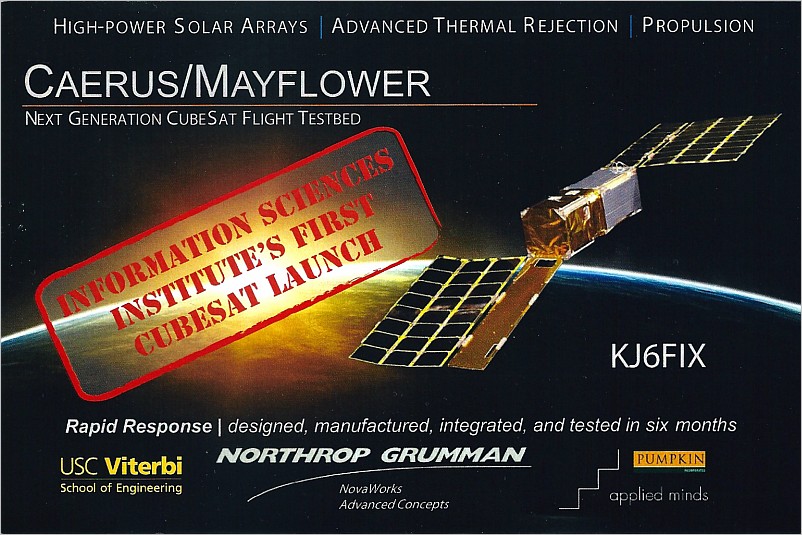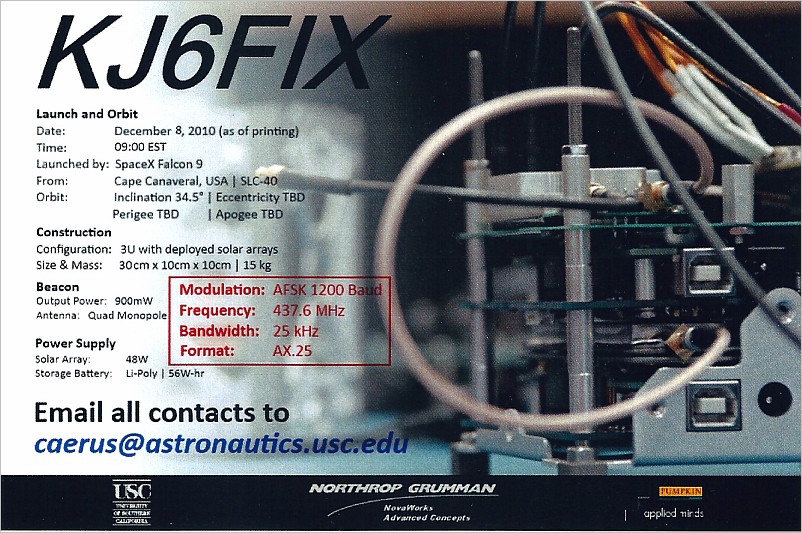The SpaceX Dragon spacecraft launched on its maiden flight on December 08, 2010, beginning a series of demonstration missions as part of NASA’s Commercial Orbital Transportation Services (COTS) programme. The mission, known as Dragon C1, launched from Cape Canaveral atop a Falcon 9 rocket at 15:43 UTC. During the flight four cubesats were deployed from the “trunk” section of the Dragon spacecraft.
CAERUS is USC’s 1st nano-satellite subsystem delivered in May 2010, and was named after the greek word for “opportunity”. It was developed from authorization to proceed (ATP) to delivery in 14 weeks. CAERUS is part of the “MAYFLOWER” Next Generation Technology Nanosatellite that is a joint effort with Northrop Grumman NOVAWORKS group. It is a 3U-size CubeSat with propulsion that has eight Pumpkin deployable solar panels unfurled into a single array.
NASA-Catalog: 37252
| Beacon437.600 MHz 1k2 AFSK, FM, 900 mW | Telemetriesignal CAERUS 1k2 AFSK |
Call
KE5RDY, KJ6FIX
Status
Dec 22, 2010: decayed
Dec 14, 2010: Due to operational considerations, the beacon will be off except in certain conditions and at variable event times which will not be predicted. Whereas tracking of the beacon is possible over the next few weeks, it is improbable.
Dec 08, 2010: First-day on-orbit telemetry from Caerus/Mayflower indicated that all systems were operating normally.
Orbital Parameter
Name MAYFLOWER NORAD 37252 COSPAR Bezeichnung 2010-066-J Inklination (Grad) 34.528 RAAN 88.482 Excentrizität 0.0011285 ARGP 8.251 Umläufe pro Tag 16.32182276 Periode 1h 28m 13s (88.22 Min) Semi-major axis 6565 km Perigäum x Apogäum 179 x 194 km Mean Anomaly 351.831
- “1U” form factor structural integration of two complete RF subsystems, with 2 separate micro-processors (PIC24’s)
- Fully qualified in Thermal Vacuum and 3-Axis Vibration
- New Antenna Module validated in the UltraLab RF Chamber on USC Campus
- Burn in with over 100 hours for Flight Software and Telemetry Systems
- Integration of 3 new Technologies (new Quad monopole deployable antenna, an RF splitter, and burn wire mechanism)
- Built and integrated by professionals and students at SERC
Telemetrie
00:47 KE5RDY-1/TCPIP>CQ>UI,?,F0 (1199 baud): 4341455255533B000200000C080A02113114730000000000405DD606008B7B280009A2F15490260214C7C6D02 AF9F80104100A040C163B1A80B2C078BF618073C06F80ADCE 00:47 KE5RDY-1/TCPIP>CQ>UI,?,F0 (1199 baud): 4341455255533B000200000C080A0211311E73000000000040BAD606008B7B280009A2F15490260214C7C6D02 AF9F80104100A040C17091D80AD807ABF658079807680A4C5 00:47 KE5RDY-1/TCPIP>CQ>UI,?,F0 (1199 baud): 4341455255533B000200000C080A021131287300000000004017D706008B7B280009A2F15490260214C7C6D02 AF9F80104100A040C17111E80AC807BBF67807D807B805581 00:47 KE5RDY-1/TCPIP>CQ>UI,?,F0 (1199 baud): 4341455255533B000200000C080A021131327300000000004074D706008B7B280009A2F15490260214C7C6D02 AF9F80104100A040C171D1D80AD807ABF698082807F80F95E 00:48 KE5RDY-1/TCPIP>CQ>UI,?,F0 (1199 baud): 4341455255533B000200000C080A0211320073000000000040D1D706008B7B280009A2F15490260214C7C6D02 AF9F80104100A040C17272080AE807BBF6A8087808380E55E 00:48 KJ6FIX-1/TCPIP>CQ>UI,?,F0 (1199 baud): 4341455255533B000200000C080A0211320A730000000000402ED806008B7B280009A2F15490260214C7C6D02 AF9F80104100A040C172F2680B0807CBF6C80898086807C2B
09.12.2010, 00:46 UTC Thanks to Tetsu san, JA0CAW
KJ6FIX-1>CQ,TCPIP/1: : 4341455255533B000200000C080A020D1B0A560000001000402EE20400D0F5230008A2F0549026821CC7C6D02 2F9F80104100A041003242080A5C07FBF8B80BDC0B98094F3 decoded packet: Total length: 59 Type:2 Unused: 0x00 0x00 Time: 12/8/10-2-13:27:10 Reboots: 86 Last Reboot Cause: 0 Flash Status: 16 Bit 0 = 0 : Device is ready. Bit 1 = 0 : Device is NOT write-enabled. Bit3&4= 1 : All sectors software-protected. Bit 4 = 1 : WP is deasserted. Bit 5 = 0 : Last op successful. Bit 7 = 0 : Sector Protection Registers unlocked. Radio Status: 64 No detailed Radio info yet TLM Pointer: 320046 PLY Pointer: 2356688 Last Sent Command: 0x08 0xa2 0xf0 0x54 0x90 0x26 0x82 0x1c 0xc7 0xc6 0xd0 0x22 0xf9 0xf8 0x01 Time: 4/16/10-4-16:3:36 Gyro Rates Data Bytes: 0x20 0x80 0xa5 0xc0 0x7f 0xbf Gyro Rates (deg/s): A: 2.34432 B: 12.0879 C: -9.450541 Gyro Rates New Data Flags: A: true B: true C: true Gyro Rates Error Flags: A: false B: true C: false Gyro Temp Data Bytes: 0x8b 0x80 0xbd 0xc0 0xb9 0x80 Gyro Temps (deg C): A: 45.1967 B: 52.4617 C: 51.8805 Gyro Temps New Data Flags: A: true B: true C: true Gyro Temps Error Flags: A: false B: true C: false Total count: 59 (Should be 83 or 59)
Ken, W7KKE heard the first beacon from CAERUS on 437.600MHz (1k2 AFSK every 10 sec) at 20:25 UTC (Dec 08, 2010)

Homepage und weitere Informationen
QSL Card

